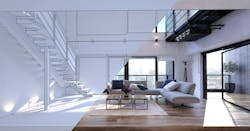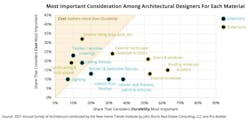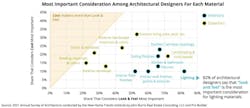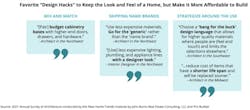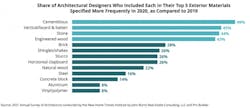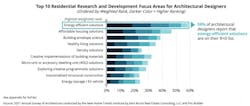3 Design Priorities Driving Product Decisions
It may be homeowners that ultimately determine the trends that define any given period’s “most popular” home designs, but it’s not without considerable input and influence from architects, designers, and other residential construction professionals, who interpret and bring to fruition that popular demand. That’s particularly true of building product selections.
In its first ever Survey of Architecture, and in partnership with Pro Builder, researchers from the New Home Trends Institute by John Burns Real Estate Consulting (JBREC) tap into the insights of more than 300 of those industry insiders to better understand what’s driving design decisions and what that means so far as product selections.
We’ve combed through the report carefully and summed up three of the survey’s most compelling, informative findings.
1. Looks > Cost > Durability
There is no factor driving design decisions more than cost vs. value. Seventy-four percent of respondents, in fact, included it as a top five consideration. But needing to justify cost doesn’t necessarily translate to “make cuts wherever you can.” It’s more nuanced.
For instance, respondents agree, so far as their clients dictate, that sacrificing durability for cost is a typically acceptable trade off on exterior living areas, textures, ceiling finishes, landscaping, and even lighting. However, cost reduction becomes less important if it means settling for a look the homeowner doesn’t want, especially as it relates to the interior.
Where pros are finding cost savings is in tweaks to the "form/shape of the home," reductions in square footage, and through "exterior materials adjustments."
“At our June Council Meeting, an architect member told us they are reducing from three to four exterior siding products per home to one to two for simplicity and cost," said Tim Seims, director of building product intelligence for JBREC, in a statement accompanying the report.
2. Exteriors Experience Change
Still, at least a quarter of respondents tried a new exterior material for the first time in 2020, and the majority (28%) did it to achieve a certain “look & feel”—possibly at a lower price point—according to respondents. As to what that “look & feel” is, data from the survey appears to provide some insight.
Cementitious, vertical/board and batten, stone, and engineered wood are all being specified over 40% more than they were last year. That increase may be the result of pros more frequently mixing and matching exterior materials.
The report reads,”forty percent of architects are mixing and matching exterior materials more frequently than they were previously.”
Of those respondents mixing and matching, more than half used an average of three materials per project. Only 3% claim to not mix and match exterior materials at all. The report also found that “durability” (18%) and “building envelope concerns” (17%) were significant drivers of new material usage.
READ MORE: 6 Innovative Products Shaping Housing's Future
3. Efficiency is a Top Priority—For Some More Than Others
What is most likely to drive design decisions over the next three years apart from cost vs. value—which, as mentioned, is the top priority for respondents at-large—is a mix of energy efficiency, biophilia, and/or health and wellness. In fact, seven of the top 10 reported priorities pros consider when making design decisions are related to one or more of those three themes.
The report reads, “seventy-eight percent of architectural designers consider at least one sustainable strategy to be a top design driver.”
Furthermore, included in the report is a top 10 of respondents’ “research and development” priorities, among which there is no focus of study more widespread than “energy-efficient solutions"—more than half of pros have it as a top priority.
Yet, despite the growing prevalence of the clean and naturalistic, the trend isn’t uniformly pirioritized. Instead, it’s “largely” driven by custom home designers, who as a group cited sustainability as a top concern more even than cost vs. value. It’s production builders that tend to place affordability above efficiency, according to the report.
